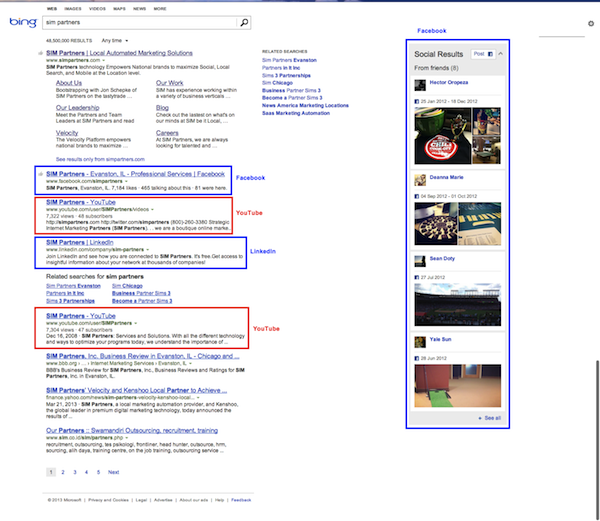Social media’s influence on search results continues to grow. This is perhaps most evident in the convergence of paid, owned, and earned media, which explains a great deal about how brands can generate activity and earn credibility through social and other earned media to significantly boost SERP visibility.
Even if marketers completely disregard the inherent benefits of effective social media programs in their own right, the growing ability of these efforts to generate credible social signals and influence search engine visibility can’t be denied.
Social Signals and Search
Activity happening on Facebook, Google+, Twitter and other top social networks continues to influence search results on Google, Bing, and other search engines. Even if brands choose not to embrace this dynamic, the actions of consumers and competitors will directly impact the scope and nature of their visibility on the SERP. This is true at the national and local level.
Nationally, brands must understand that top search engines have carved out some high profile places to present search results from chosen or affiliated social networks.

Google+ content, for example, often occupies a portion of the highest profile Google SERP real estate.

Bing has gone to great lengths to incorporate social signals into its search results via the Bing social sidebar, recently adding five times more Facebook content. On the social search side, results from Facebook’s Graph Search are generated entirely from a searcher’s social network and other information available publicly on Facebook.
Brands with multiple brick-and-mortar locations or advisors, however, face an opportunity perhaps 40 times as great when marketing at the local level. According to a study by Mainstay Salire, local Facebook pages receive five times more marketing reach and eight times more engagement per fan than corporate pages.
Creating these unique social identities and extending organized, branded support for each location pays off for brands, and this strategy has been working for quite awhile. More than a year ago, for example, Google+ local marketing pilot programs were already moving the needle for brands. Today, each and every brand should harness the power of social signals if they hope to maximize search visibility going forward.
How Can Brands in Highly Regulated Industries Capitalize?
Most big brand marketers need very little coaxing to embrace this opportunity, but what about brands in highly regulated industries? Marketers working in financial services, health care and pharmaceuticals, or insurance, for example, must convince their organizations to balance the need to minimize liability with the opportunity to generate visibility.
Somewhat surprisingly, regulatory bodies overseeing some of our most closely watched industries acknowledge the business opportunity social media presents and encourage their industries to embrace it. Take financial services, for example. Historically, regulatory groups have focused on mitigating risk.
In a very different way, these groups continue their track record of risk mitigation today. Groups like the Financial Industry Regulatory Authority (FINRA), the Securities and Exchange Commission (SEC), the Federal Financial Institutions Examination Council (FFIEC) and others don’t want to get in the way of their industry embracing the game-changing potential of social media.
These groups do, of course, regulate how social media ought to be leveraged to some extent, but they overwhelmingly focus guidance on the need for brands to archive, monitor, and manage social communications. They focus less on actual social communications and more on the infrastructure and procedures a brand puts in place, as well as the due diligence it performs.
In a nutshell, financial services firms’ social media policies must establish responsibilities specific to social media. To ensure FINRA compliance, these brands must archive and monitor any and all social media activity. When combined with an employee training program, these measures can insulate brands from liability, even if one of their own commits a violation.
Social CRM Technology Eases the Compliance and Regulatory Burden
Maintaining compliance becomes infinitely more complex when national brands empower local entities or advisors, like when a financial services company empowers each financial advisor within its national network to create its own local social media presence. When national brand managers take this step, they decentralize responsibility and spread the risk across hundreds or thousands of individuals.
Top social CRM platforms make it much easier for brand managers in any industry to maintain control of all social activity and ensure brand consistency, but many of these platforms fall short of ensuring compliance with industry regulations. Companies in highly regulated industries can simplify the selection process by insisting on a social CRM platform deemed compliant with their own industry’s regulations.
The best tools go even further, leveraging automation and scalability to empower national brands to maximize social, local search, and mobile results at the location level, but companies governed by regulatory bodies should have their requirements in hand as they decide which tool to employ. They should seek out a tool that minimally offers:
- Enterprise-ready industry-specific compliance: Financial services providers, for example, should seek out FINRA compliant technologies.
- Automated audit and approval processes: The chosen technology should track every post and conversation across each location’s social accounts with audit and approval processes and trails.
- Corporate-controlled content libraries: These enable national brands to share preapproved content, messages, photos, videos, etc. with their many locations, who can then put the compliant resources into an engaging local context.
- Archiving: Keeping record of all communications is key to maintaining compliance in most regulated industries.
- Reporting: Brands should track and report progress against goals nationally and specific to each location.
When regulatory bodies encourage their industries to more aggressively adopt social media, brands should respond by convincing management teams to dive in, taking the required steps to ensure compliance while getting their social media programs off the ground as soon as possible. The search engines are listening, but brands must step up and start sending the right signals.

